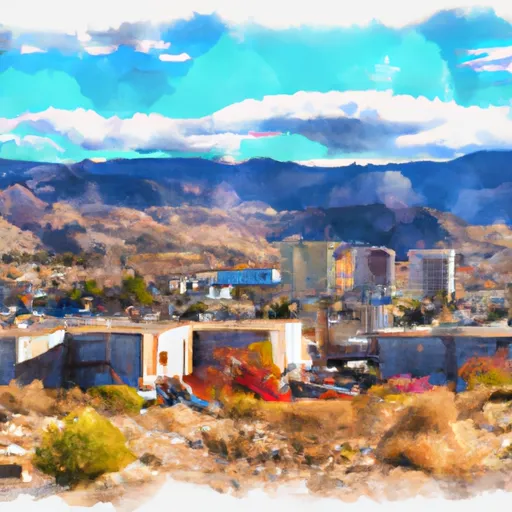-
 Snoflo Premium
Snoflo Premium
Get unlimited access to all our content
With no Ad interruptions! - Start Your Free Trial Login with existing account
Spring-Creek
Eden Index
Climate
7.4
•
Recreation
5.2
•
Community
•
Safeguard
4.8/10

Spring Creek is a small town located in northeastern Nevada, situated in Elko County. Known for its picturesque landscapes and outdoor recreational opportunities, Spring Creek offers a unique experience for nature enthusiasts. The climate in Spring Creek is characterized by hot, dry summers and cold winters. Summer temperatures can soar above 90°F (32°C), while winter temperatures can drop below freezing.
Hydrologically, Spring Creek is blessed with abundant water resources. The town is surrounded by numerous creeks and springs, which contribute to a healthy hydrological system in the area. These water sources not only provide aesthetic value but also support a diverse range of wildlife.
Outdoor recreation opportunities in Spring Creek are plentiful. The town is nestled within the beautiful Ruby Mountains, offering opportunities for hiking, camping, and wildlife viewing. Anglers can enjoy fishing in the nearby rivers and streams, which are stocked with various fish species. Additionally, Spring Creek boasts excellent hunting opportunities, attracting hunters from far and wide.
In conclusion, Spring Creek, Nevada, is renowned for its stunning landscapes, favorable climate, and abundant water resources. Its proximity to the Ruby Mountains provides a plethora of outdoor activities, making it an ideal destination for nature lovers and adventure seekers.
What is the Eden Index?
The Snoflo Eden Index serves as a comprehensive rating system for regions, evaluating their desirability through a holistic assessment of climate health, outdoor recreation opportunities, and natural disaster risk, acknowledging the profound impact of these factors on livability and well-being.
Climate Health Indicator (CHI): 7.4
Spring-Creek receives approximately
326mm of rain per year,
with humidity levels near 64%
and air temperatures averaging around
7°C.
Spring-Creek has a plant hardyness factor of
5, meaning
plants and agriculture in this region thrive during a short period during spring and early summer. Most
plants will die off during the colder winter months.
By considering the ideal temperature range, reliable water supplies, clean air, and stable seasonal rain or snowpacks, the Climate Health Indicator (CHI) underscores the significance of a healthy climate as the foundation for quality living.
A healthy climate is paramount for ensuring a high quality of life and livability in a region, fostering both physical well-being and environmental harmony. This can be characterized by ideal temperatures, reliable access to water supplies, clean air, and consistent seasonal rain or snowpacks.
Weather Forecast
Streamflow Conditions
Humboldt
Area Rivers
Humboldt
Snowpack Depths
Humboldt
Reservoir Storage Capacity
Humboldt
Groundwater Levels
Recreational Opportunity Index (ROI): 5.2
The Recreational Opportunity Index (ROI) recognizes the value of outdoor recreational options, such as parks, hiking trails, camping sites, and fishing spots, while acknowledging that climate plays a pivotal role in ensuring the comfort and consistency of these experiences.
Access to outdoor recreational opportunities, encompassing activities such as parks, hiking, camping, and fishing, is crucial for overall well-being, and the climate plays a pivotal role in enabling and enhancing these experiences, ensuring that individuals can engage in nature-based activities comfortably and consistently.
Camping Areas
| Campground | Campsites | Reservations | Toilets | Showers | Elevation |
|---|---|---|---|---|---|
| Zunino/Jiggs Reservoir | None | 5,580 ft | |||
| South Fork Reservoir | 25 | 5,251 ft | |||
| South Ruby | 35 | 6,140 ft | |||
| Ruby Lake | 35 | 6,062 ft |
Catastrophe Safeguard Index (CSI):
The Catastrophe Safeguard Index (CSI) recognizes that natural disaster risk, encompassing floods, fires, hurricanes, and tornadoes, can drastically affect safety and the overall appeal of an area.
The level of natural disaster risk in a region significantly affects safety and the overall livability, with climate change amplifying these risks by potentially increasing the frequency and intensity of events like floods, fires, hurricanes, and tornadoes, thereby posing substantial challenges to community resilience and well-being.
Community Resilience Indicator (CRI):
The Community Resilience Indicator (CRI) recognizes that education, healthcare, and socioeconomics are crucial to the well-being of a region. The CRI acknowledges the profound impact of these elements on residents' overall quality of life. By evaluating educational resources, healthcare accessibility, and economic inclusivity, the index captures the essential aspects that contribute to a thriving community, fostering resident satisfaction, equity, and social cohesion.

